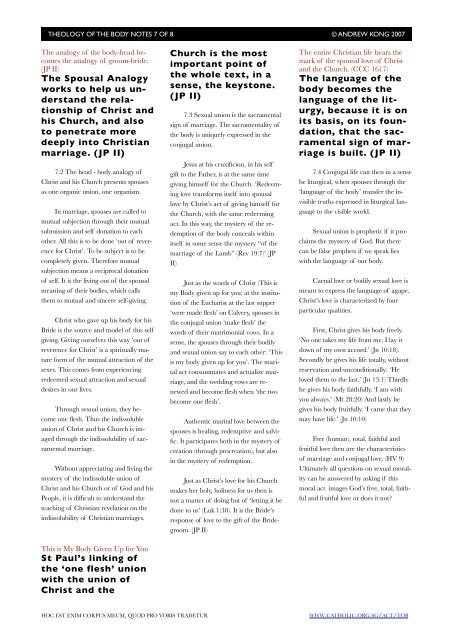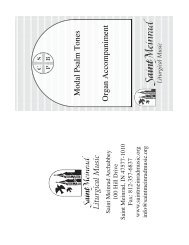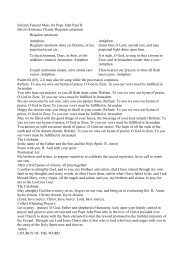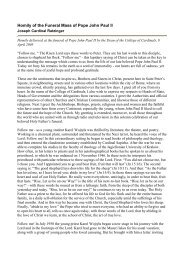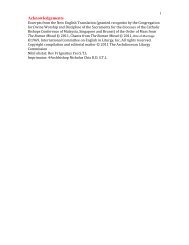Why Sexual Desires?
Why Sexual Desires?
Why Sexual Desires?
You also want an ePaper? Increase the reach of your titles
YUMPU automatically turns print PDFs into web optimized ePapers that Google loves.
THEOLOGY OF THE BODY NOTES 7 OF 8 ! © ANDREW KONG 2007<br />
The analogy of the body-head becomes<br />
the analogy of groom-bride.<br />
(JP II)<br />
The Spousal Analogy<br />
works to help us understand<br />
the relationship<br />
of Christ and<br />
his Church, and also<br />
to penetrate more<br />
deeply into Christian<br />
marriage. ( JP II)<br />
7.2 The head - body analogy of<br />
Christ and his Church presents spouses<br />
as one organic union, one organism.<br />
In marriage, spouses are called to<br />
mutual subjection through their mutual<br />
submission and self donation to each<br />
other. All this is to be done ‘out of reverence<br />
for Christ’. To be subject is to be<br />
completely given. Therefore mutual<br />
subjection means a reciprocal donation<br />
of self. It is the living out of the spousal<br />
meaning of their bodies, which calls<br />
them to mutual and sincere self-giving.<br />
Christ who gave up his body for his<br />
Bride is the source and model of this self<br />
giving. Giving ourselves this way ‘out of<br />
reverence for Christ’ is a spiritually mature<br />
form of the mutual attraction of the<br />
sexes. This comes from experiencing<br />
redeemed sexual attraction and sexual<br />
desires in our lives.<br />
Through sexual union, they become<br />
one flesh. Thus the indissoluble<br />
union of Christ and his Church is imaged<br />
through the indissolubility of sacramental<br />
marriage.<br />
Without appreciating and living the<br />
mystery of the indissoluble union of<br />
Christ and his Church or of God and his<br />
People, it is difficult to understand the<br />
teaching of Christian revelation on the<br />
indissolubility of Christian marriages.<br />
This is My Body Given Up for You<br />
St Paul’s linking of<br />
the ‘one flesh’ union<br />
with the union of<br />
Christ and the<br />
Church is the most<br />
important point of<br />
the whole text, in a<br />
sense, the keystone.<br />
( JP II)<br />
7.3 <strong>Sexual</strong> union is the sacramental<br />
sign of marriage. The sacramentality of<br />
the body is uniquely expressed in the<br />
conjugal union.<br />
Jesus at his cruxificion, in his self<br />
gift to the Father, is at the same time<br />
giving himself for the Church. ‘Redeeming<br />
love transforms itself into spousal<br />
love by Christ’s act of giving himself for<br />
the Church, with the same redeeming<br />
act. In this way, the mystery of the redemption<br />
of the body conceals within<br />
itself in some sense the mystery “of the<br />
marriage of the Lamb” (Rev 19:7)’ (JP<br />
II)<br />
Just as the words of Christ (This is<br />
my Body given up for you) at the institution<br />
of the Eucharist at the last supper<br />
‘were made flesh’ on Calvery, spouses in<br />
the conjugal union ‘make flesh’ the<br />
words of their matrimonial vows. In a<br />
sense, the spouses through their bodily<br />
and sexual union say to each other: ‘This<br />
is my body given up for you’. The marital<br />
act consummates and actualize marriage,<br />
and the wedding vows are renewed<br />
and become flesh when ‘the two<br />
become one flesh’.<br />
Authentic marital love between the<br />
spouses is healing, redemptive and salvific.<br />
It participates both in the mystery of<br />
creation (through procreation), but also<br />
in the mystery of redemption.<br />
Just as Christ’s love for his Church<br />
makes her holy, holiness for us then is<br />
not a matter of doing but of ‘letting it be<br />
done to us’ (Luk 1:38). It is the Bride’s<br />
response of love to the gift of the Bridegroom.<br />
(JP II)<br />
The entire Christian life bears the<br />
mark of the spousal love of Christ<br />
and the Church. (CCC 1617)<br />
The language of the<br />
body becomes the<br />
language of the liturgy,<br />
because it is on<br />
its basis, on its foundation,<br />
that the sacramental<br />
sign of marriage<br />
is built. ( JP II)<br />
7.4 Conjugal life can then in a sense<br />
be liturgical, when spouses through the<br />
‘language of the body’ transfer the invisible<br />
truths expressed in liturgical language<br />
to the visible world.<br />
<strong>Sexual</strong> union is prophetic if it proclaims<br />
the mystery of God. But there<br />
can be false prophets if we speak lies<br />
with the language of our body.<br />
Carnal love or bodily sexual love is<br />
meant to express the language of agape.<br />
Christ’s love is characterized by four<br />
particular qualities.<br />
First, Christ gives his body freely.<br />
‘No one takes my life from me, I lay it<br />
down of my own accord.’ (Jn 10:18).<br />
Secondly he gives his life totally, without<br />
reservation and unconditionally: ‘He<br />
loved them to the last.’ (Jn 13:1) Thirdly<br />
he gives his body faithfully. ‘I am with<br />
you always.’ (Mt 28:20) And lastly he<br />
gives his body fruitfully. ‘I came that they<br />
may have life.’ (Jn 10:10)<br />
Free (human), total, faithful and<br />
fruitful love then are the characteristics<br />
of marriage and conjugal love. (HV 9)<br />
Ultimately all questions on sexual morality<br />
can be answered by asking if this<br />
moral act images God’s free, total, faithful<br />
and fruitful love or does it not<br />
HOC EST ENIM CORPUS MEUM, QUOD PRO VOBIS TRADETUR<br />
WWW.CATHOLIC.ORG.SG/ACT/TOB


